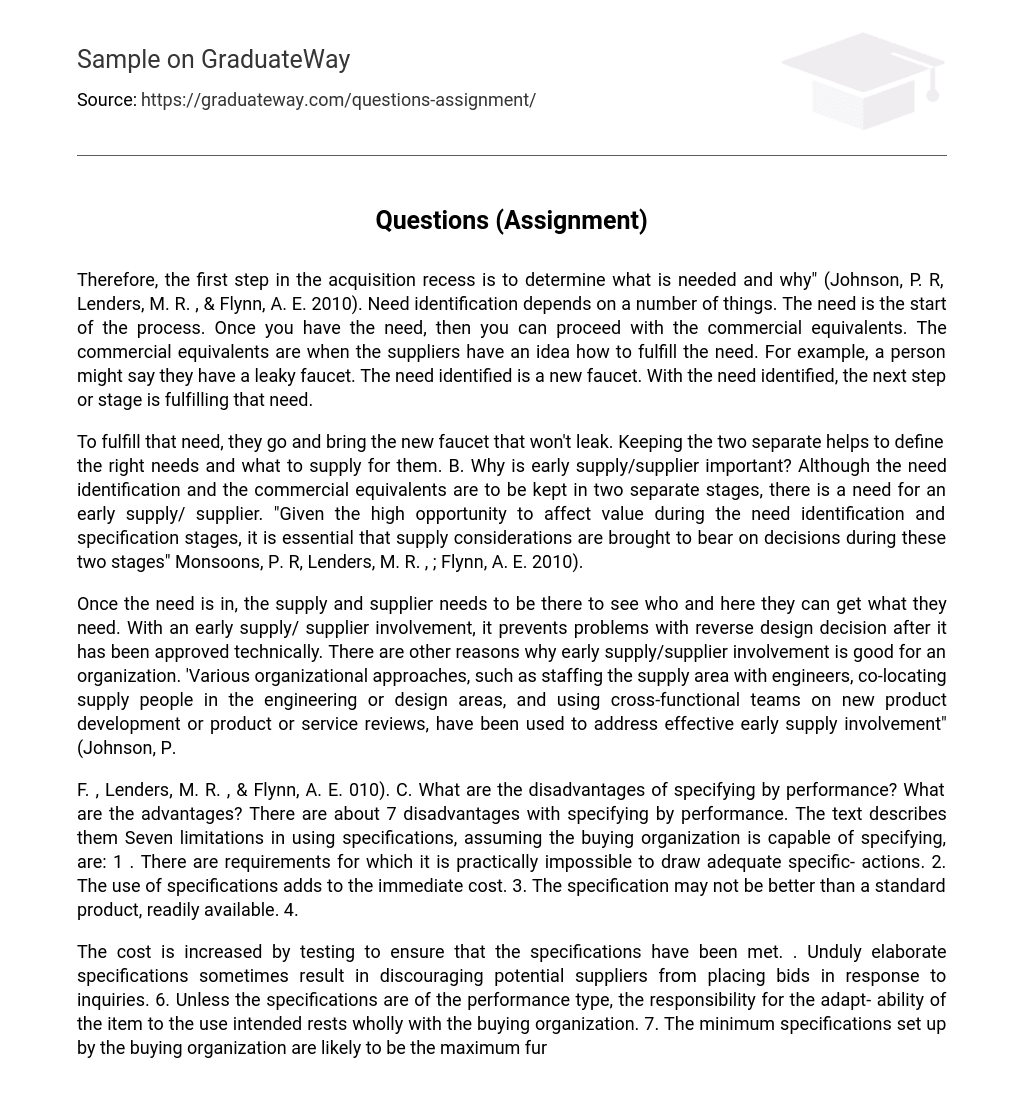Therefore, the first step in the acquisition recess is to determine what is needed and why” (Johnson, P. R, Lenders, M. R. , & Flynn, A. E. 2010). Need identification depends on a number of things. The need is the start of the process. Once you have the need, then you can proceed with the commercial equivalents. The commercial equivalents are when the suppliers have an idea how to fulfill the need. For example, a person might say they have a leaky faucet. The need identified is a new faucet. With the need identified, the next step or stage is fulfilling that need.
To fulfill that need, they go and bring the new faucet that won’t leak. Keeping the two separate helps to define the right needs and what to supply for them. B. Why is early supply/supplier important? Although the need identification and the commercial equivalents are to be kept in two separate stages, there is a need for an early supply/ supplier. “Given the high opportunity to affect value during the need identification and specification stages, it is essential that supply considerations are brought to bear on decisions during these two stages” Monsoons, P. R, Lenders, M. R. , ; Flynn, A. E. 2010).
Once the need is in, the supply and supplier needs to be there to see who and here they can get what they need. With an early supply/ supplier involvement, it prevents problems with reverse design decision after it has been approved technically. There are other reasons why early supply/supplier involvement is good for an organization. ‘Various organizational approaches, such as staffing the supply area with engineers, co-locating supply people in the engineering or design areas, and using cross-functional teams on new product development or product or service reviews, have been used to address effective early supply involvement” (Johnson, P.
F. , Lenders, M. R. , & Flynn, A. E. 010). C. What are the disadvantages of specifying by performance? What are the advantages? There are about 7 disadvantages with specifying by performance. The text describes them Seven limitations in using specifications, assuming the buying organization is capable of specifying, are: 1 . There are requirements for which it is practically impossible to draw adequate specific- actions. 2. The use of specifications adds to the immediate cost. 3. The specification may not be better than a standard product, readily available. 4.
The cost is increased by testing to ensure that the specifications have been met. . Unduly elaborate specifications sometimes result in discouraging potential suppliers from placing bids in response to inquiries. 6. Unless the specifications are of the performance type, the responsibility for the adapt- ability of the item to the use intended rests wholly with the buying organization. 7. The minimum specifications set up by the buying organization are likely to be the maximum furnished by the supplier. (Johnson, P. F. , Lenders, M. R. , & Flynn, A. E. 2010). However, even with these limitations, it’s not all bad.
There are 5 good reasons that specifying by performance can be used. The text describes as Traditional advantages of buying with specifications include: 1. Evidence exists that thought and careful study have been given to the need and the ways in which it may be satisfied. 2. A standard is established for measuring and checking materials as supplied, preventing delay and waste that would occur with improper materials. 3. An opportunity exists to purchase identical requirements from a number of different sources of supply. 4. The potential exists for equitable competition.
This is why public agencies place such a premium on specification writing. In securing bids from various suppliers, a buyer must be sure that the suppliers are quoting for exactly the same material or service. 5. The seller will be responsible for performance when the buyer specifies performance. (Johnson, P. F. , Lenders, M. R. , ; Flynn, A. E. 2010). D. How does a supply professional know that a certain requirement is strategic? In order for the supply professional to know if a certain requirement is strategic, there are a few attributes that have to be in place.





